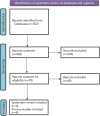Burden of disease of respiratory syncytial virus in infants, young children and pregnant women and people
- PMID: 38511049
- PMCID: PMC10949905
- DOI: 10.14745/ccdr.v50i12a01
Burden of disease of respiratory syncytial virus in infants, young children and pregnant women and people
Abstract
Background: Passive immunization products for infants and pregnant women and people have sparked interest in understanding Canada's respiratory syncytial virus (RSV) burden. This rapid review examines RSV burden of disease in infants, young children and pregnant women and people.
Methods: Electronic databases were searched to identify studies and systematic reviews reporting data on outpatient visits, hospitalizations, intensive care unit admissions, deaths and preterm labour associated with RSV. We also contacted Canadian respiratory virus surveillance experts for additional data.
Results: Overall, 17 studies on infants and young children and 10 studies on pregnant women and people were included, in addition to primary surveillance data from one Canadian territory (Yukon). There were higher rates of medical utilization for infants than older children. Hospitalization rates were highest in infants under six months (more than 1% annually), with 5% needing intensive care unit admission, but mortality was low. Severe outcomes often occurred in healthy full-term infants and burden was higher than influenza. Respiratory syncytial virus attack rate was 10%-13% among pregnant women and people. Only one study found a higher hospitalization rate in pregnant women and people compared to non-pregnant women and people. Limited evidence was found on intensive care unit admission, death and preterm birth for pregnant women and people.
Conclusion: While risk of severe outcomes is larger in high-risk infants and children, healthcare burden is greatest in healthy term infants. The RSV severity for pregnant women and people appears to be similar to that for non-pregnant women and people.
Keywords: burden of disease; epidemiology; infants; respiratory syncytial virus; surveillance.
Conflict of interest statement
Competing interests None.
Figures
References
-
- Zylbersztejn A, Pembrey L, Goldstein H, Berbers G, Schepp R, van der Klis F, Sande C, Mason D, Wright J, Smyth R, Hardelid P. Respiratory syncytial virus in young children: community cohort study integrating serological surveys, questionnaire and electronic health records, Born in Bradford cohort, England, 2008 to 2013. Euro Surveill 2021;26(6):2000023. 10.2807/1560-7917.ES.2021.26.6.2000023 - DOI - PMC - PubMed
-
- Mazur NI, Terstappen J, Baral R, Bardají A, Beutels P, Buchholz UJ, Cohen C, Crowe JE Jr, Cutland CL, Eckert L, Feikin D, Fitzpatrick T, Fong Y, Graham BS, Heikkinen T, Higgins D, Hirve S, Klugman KP, Kragten-Tabatabaie L, Lemey P, Libster R, Löwensteyn Y, Mejias A, Munoz FM, Munywoki PK, Mwananyanda L, Nair H, Nunes MC, Ramilo O, Richmond P, Ruckwardt TJ, Sande C, Srikantiah P, Thacker N, Waldstein KA, Weinberger D, Wildenbeest J, Wiseman D, Zar HJ, Zambon M, Bont L. Respiratory syncytial virus prevention within reach: the vaccine and monoclonal antibody landscape. Lancet Infect Dis 2023;23(1):e2–21. 10.1016/S1473-3099(22)00291-2 - DOI - PMC - PubMed
-
- GBD 2016 Lower Respiratory Infections Collaborators . Estimates of the global, regional, and national morbidity, mortality, and aetiologies of lower respiratory infections in 195 countries, 1990-2016: a systematic analysis for the Global Burden of Disease Study 2016. Lancet Infect Dis 2018;18(11):1191–210. 10.1016/S1473-3099(18)30310-4 - DOI - PMC - PubMed



